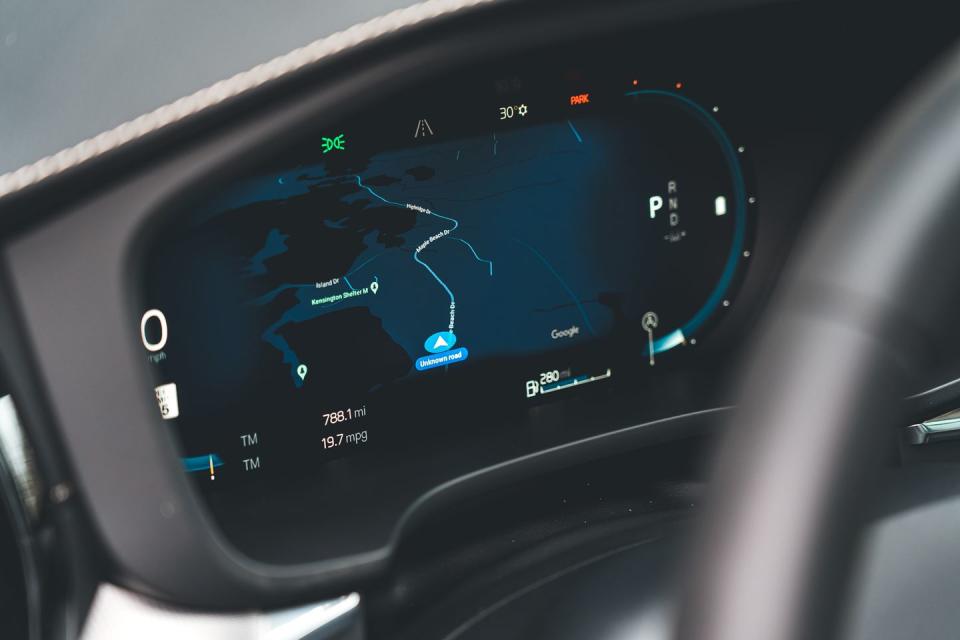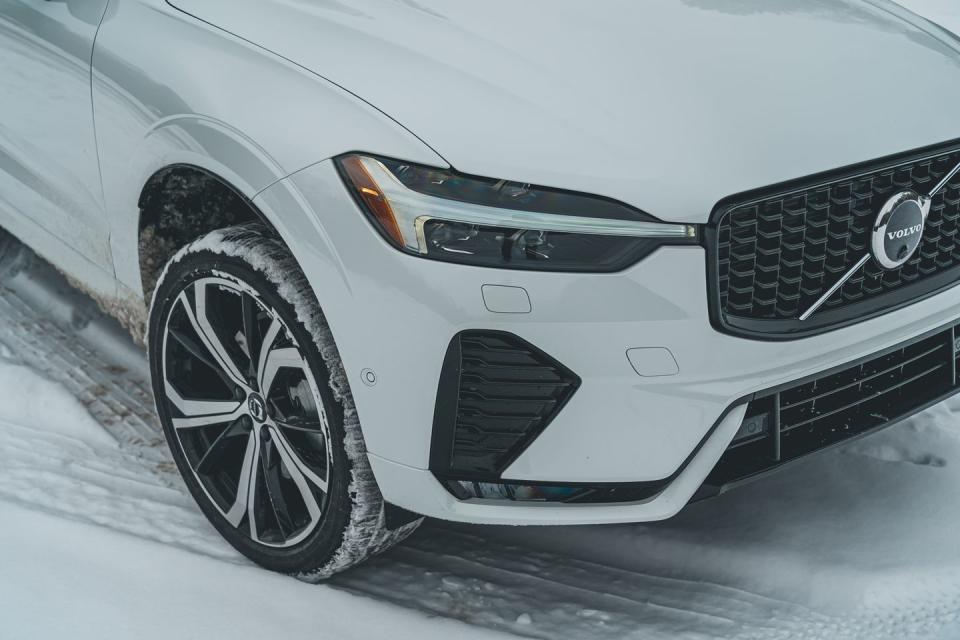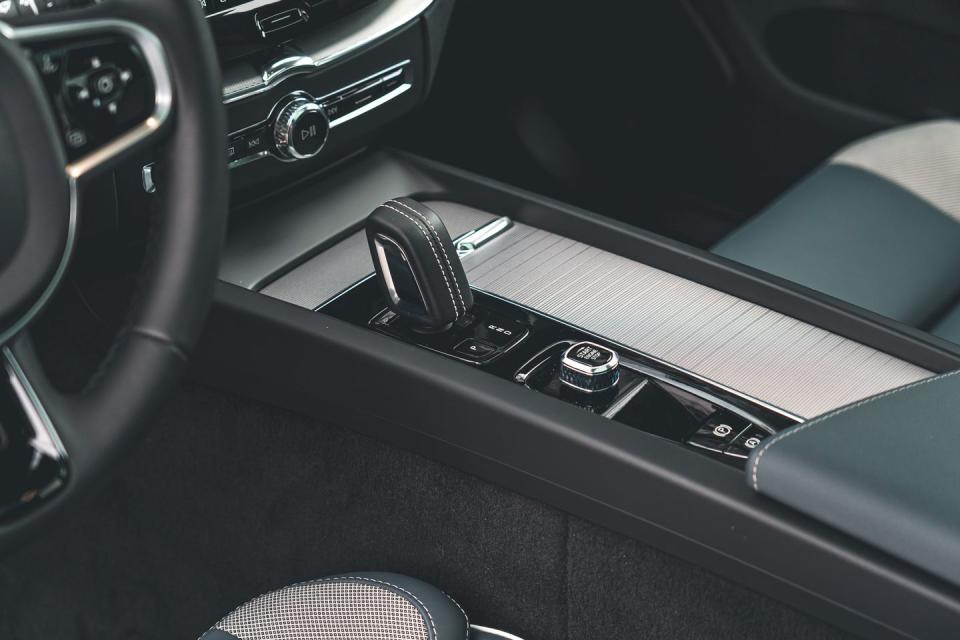Tested: 2022 Volvo XC60 Inches toward Electrification

UPDATE 3/11/22: This review has been updated with test results for the XC60 B6 model.
Eager to cast itself as a forward-thinking automaker, Volvo has stated that it will sell only electric vehicles starting in 2030, which is sooner than most competitors. So far, the brand has two EVs in its stable: the XC40 Recharge and its mechanical twin, the C40 Recharge. Its other Recharge models, the XC60 T8 and the XC90 T8, are plug-in hybrids—a half step toward a battery-powered future. Now the two mainstream versions of the Volvo XC60 (the brand's most popular model)—along with the S60 sedan, the S90 sedan, and the V90 Cross Country wagon—add hybridization to their powertrains. It's a 48-volt hybrid system, the tiniest baby step on the road to electrification.
As before, the XC60 powertrains all use a 2.0-liter inline-four. The arrival of the 48-volt hybrid system, however, brings with it a change in nomenclature. The base T5 is now known as B5, while the step-up T6 becomes the B6. (The unchanged plug-in-hybrid variants, which offer 19 miles of electric-only range, continue as the T8 with 400 total horsepower, or 415 in the Polestar Engineered model.) All models continue with an eight-speed automatic. The B5 has front-wheel drive or all-wheel drive, with AWD standard elsewhere.

The 48-volt system does not boost the power output of either the B5 or the B6. The base powertrain, which is turbocharged, now makes 247 horsepower (down from 250) along with the same 258 pound-feet of torque as before. The turbocharged and supercharged version, which also swaps out its previous belt-driven supercharger for an electrically driven blower, slips from 316 horsepower to 295 horsepower but sees a torque increase from 295 pound-feet to 310.
The hybrid system does help the XC60 eke out minor fuel-economy gains. EPA estimates for the front-wheel-drive base car improve by 1 mpg in both city and highway tests, to 23/30 mpg city/highway. The all-wheel-drive B5 and the B6 both add 1 mpg city compared with their 2021 predecessors, with estimates of 22/28 mpg (B5 AWD) and 21/27 mpg (B6).

In a long-term test of an XC60 T6, we averaged 23 mpg over 40,000 miles. We also recorded a 60-mph time of 5.4 seconds. The new B6 version we tested was significantly slower, taking 6.6 seconds to reach that mark, and its 15.0-second, 93-mph quarter-mile pass is a full second and 7 mph behind its T6 predecessor's. The Audi Q5 45, the BMW X3 30i, and the Mercedes-Benz GLC300 all are quicker to 60 mph.
Subjectively, the new XC60 B6 doesn't feel slower, because the 48-volt starter-generator bolsters the engine's horsepower and torque at lower engine speeds. Moreover, the electric assists do a good job of masking any turbo lag. Response to light throttle applications is now more linear and less surgy, whether you're calling for slightly more speed or moving off from a stop. And when you put the hammer down at 30 mph, the time to accelerate to 50 mph is marginally quicker than before.

The starter-generator also makes for seamless auto restarts, which may keep more drivers from switching off the auto stop-start system. Also on the subject of stop-and-go driving, the switch to a brake-by-wire system, to maximize regenerative braking, is one that's imperceptible from the driver's seat, as the brake pedal modulation feels no different from a conventional brake system. The new setup also hauled the car to a stop from 70 mph in just 164 feet, which is five feet shorter than before. And lastly, there's a new alert to let an inattentive driver know when the vehicle ahead has begun moving, although it's not as quick acting as the NYC cabby behind you.

The XC60's suspension remains unaltered, and the R-Design car we drove was equipped with the optional 4C adaptive dampers. Aside from some initial lean in corners, the adaptive dampers do a good job of quelling body motions. But riding on the optional 21-inch wheels, the XC60 still feels heavy-footed over broken pavement. We measured a decent 0.86 g on the skidpad, putting the Volvo's cornering grip almost exactly on a par with the Q5, the X3, and the GLC300.
The current XC60 has been around since the 2018 model year, and with 2022 marking the traditional mid-cycle refresh point, Volvo obliges with additional changes beyond the mechanicals.

The midpoint makeover includes a subtle exterior nip-tuck consisting of a new grille texture, a restyled lower fascia, new wheel designs, and a new rear bumper that hides the tailpipes. The neatest exterior feature is one you can't see: The logo at the center of the grille is now heated, to prevent ice buildup that would block the sensors contained therein.
Inside, there's newly available wool-blend upholstery, part of Volvo's move toward more leather alternatives. (The company recently announced that its EVs will be leather-free.) It's a no-cost option on the Inscription model. The spare, Scandinavian interior largely remains as before, with adequate room for four adults, a cargo hold that falls midpack in this segment, and just a bare minimum of cabin stowage space.

The only significant in-cabin update is that Volvo's infotainment system switches to a Google-based operating system. Google Maps is now your navigation system, Google Play runs the music, and the Siri-style Google Assistant is on hand to answer your queries. The 9.0-inch vertically oriented touchscreen is physically unchanged, and the homepage (reached via the system's lone physical button) continues to feature four horizontal tiles for navigation, audio, phone, and Google Assistant. The system can receive over-the-air updates, and it will need them, as the early-production cars we drove were missing satellite radio as well as Android Auto and Apple CarPlay—all set to become available via updates.
The Google Maps navigation system runs Volvo-specific fonts, and the graphics look great, both on the screen and in the standard 12.3-inch digital instrument cluster. As before, the latter offers a bimodal choice of display: with a map or without.

There is no change to the (very) limited set of buttons below the screen, which means that for the audio system, there's a volume knob, buttons to seek up or down, and not much else. A tuning knob would be welcome, as it currently takes multiple presses of the seek button or several swipes to go from, say, 93.9 WNYC to 107.1 WFUV.
One change to the screen layout is that at the very base of the display, there's now a touchpoint to call up the surround-view camera, meaning you no longer have to go digging for it in menus. Even better, the camera now appears automatically when the car pulls up to the curb, just as it does when shifting into reverse.

Prices start at $43,745 for the front-wheel-drive XC60 B5 in Momentum trim. The B6 skips the base setup and starts off at the R-Design level for $56,195 with standard AWD. Things top out at $70,595 for the XC60 T8 Recharge Polestar Engineered.
The XC60's latest move toward electrification brings minor improvements in drivability and fuel economy for the mainstream models. That should help to keep the brand's bestseller up to date until the brave new battery-powered future arrives.

You Might Also Like

 Yahoo Autos
Yahoo Autos 